
The Honda VF and VFR series is a range of motorcycles first introduced in 1982 by Honda featuring V4 engines (hence the "VF" prefix).

The Honda VF and VFR series is a range of motorcycles first introduced in 1982 by Honda featuring V4 engines (hence the "VF" prefix).
In 1969 Honda revealed the CB750 superbike, establishing the template for the Universal Japanese Motorcycle with a range of transverse inline-fours. Relishing technological innovation, Honda unexpectedly moved on to adopt the V4 ("VF") configuration. However, some of the early VF models suffered mechanical problems, mainly as a result of poor quality camshafts (the "chocolate cams"). Honda, alarmed that they were losing their hard-won reputation for reliability, moved to introduce the VFR750 motorcycles featuring gear-driven over head cams and a very high build quality. The first three or four iterations of VFR motorcycles re-established Honda's reputation for quality, and the motorcycles received almost universal praise from journalists and riders alike.
The VFR was originally a 750 cc, but became an 800 cc in due course. New models featured technological innovation, such as a single-sided swingarm, linked braking, ABS, and VTEC. The VFR1200 became the first motorcycle to feature a dual-clutch transmission. Not all of these innovations proved popular with riders, who often preferred the simple robustness of the earlier models.
Honda also developed a limited edition VFR, the Honda RC30, as a homologation racing platform. This motorcycle achieved some racing success, but the introduction of very light inline-four motorcycles by competing firms led Honda to downgrade its racing plans.
Honda's VF model lineup had engine capacities ranging from 400 cc to 1,000 cc. Another Honda, the shaft-driven ST1100 also featured a V4 engine, but this touring motorcycle does not form part of the VF series.
Prior to its adoption by Honda, the V4 design had been used only rarely for motorcycles, most notably by Matchless. [1] In modern times, the V4 configuration has been embraced by Aprilia, Ducati, Suzuki, Yamaha & Norton.
Compared to an in-line four, the advantages of a 90° V4 engine include compactness, narrow width, and perfect primary balance giving a smooth and nearly vibration-free operation. A disadvantage is that it is more expensive to manufacture, and, just like a V-twin, more difficult to locate ancillaries and inlet & exhaust systems.

In 1982 VF models were introduced to the public at the Cologne Motorcycle Show with a V4 engine mounted in a square-tube steel frame. [2] That very year, reliability and quality control problems arose, possibly due to new automated production equipment at Honda's plant in Hamamatsu, Japan.[ citation needed ] Regardless, Honda sold out its first year's inventory of Sabres and the Magnas were not far behind. 1983 saw the engine revised to correct the problems from the previous production year and the introduction of the V65 and the Interceptor. Cam-wear problems surfaced during 1984 in the larger displacement bikes, which, by the time it was corrected, led to eight factory cam revisions over the course of just one year.[ citation needed ]

The 748 cc VFR750F (RC24) was introduced in 1986, and was over-engineered in a bid to re-establish a reputation for reliability. It had an alloy beam frame, gear driven cams. This version underwent constant revision of the non-US models with later revisions including changing wheel sizes from 16" front & 18" rear to 17" front and rear, larger diameter forks and the fairing was slightly modified. After this was a series of VFR models which featured various innovations, including a single-sided swingarm, linked braking, ABS, and VTEC. In due course the geared cam drive was dropped in favour of cheaper chain-drive.
A total redesign of the engine to a new one based on the RVF750R (RC45) and a slight capacity increase led to later models being designated the "VFR800F".
A much larger capacity VFR model, the VFR1200F, was revealed at the Tokyo Motor Show in October 2009. [3] [4] The new 1,200 cc (73 cu in) narrow-angle SOHC V4 engine [5] does not use the V-Tec design of the smaller VFRs. It has an optional six-speed push-button operated dual clutch transmission with three modes: automatic, sport and manual. The modes are similar to those on the Honda DN-01 but with a conventional gearbox shifted automatically, similar to a "Tiptronic" system, and without a hand-operated clutch rather than a hydrostatic drive. [6] [7] [8]
To date, the VFR1200 has not sold particularly well, as buyers have tended to favour the smaller VFR800F (RC79).
Honda have permitted the Ariel Motor Company, British makers of the Ariel Atom sports car, to use the VFR1200's V4 engine in a new motorcycle, the Ariel Ace.
Honda developed the RC30 as a homologation racing version which was used from 1988 to 1993. It was the first large capacity motorcycle to use a single-sided swingarm.[ citation needed ]. The RC30 was succeeded in 1994 by the RC45.

The Honda Magna is a cruiser motorcycle made from 1982 to 1988 and 1994 to 2003 and was the second Honda to use their new V4 engine shared with the VF750S Sabre and a few years later a related engine was fitted to the VF750F 'Interceptor', the later models used a retuned engine from the VFR750F with fins added to the outside of the engine. The engine technology and layout was a descendant of Honda's racing V4 machines, such as the NS750 and NR750. The introduction of this engine on the Magna and the Sabre in 1982, was a milestone in the evolution of motorcycles that would culminate in 1983 with the introduction of the Interceptor V4. The V45's performance is comparable to that of Valkyries and Honda's 1800 cc V-twin cruisers. However, its mix of performance, reliability, and refinement was overshadowed by the more powerful 1,098 cc "V65" Magna in 1983.

The Honda VFR400 series of motorcycles were a related series of 399 cc V4-engined motorcycles, which were essentially scaled-down versions of the larger VFR race models of the day. They were mainly developed for, and sold in, the Japanese domestic market, in part due to the tougher motorcycle drivers' license restrictions in Japan at the time for motorcycles with displacement exceeding 400cc.
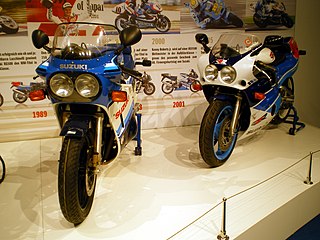
Suzuki GSX-R is a series of sports motorcycles made by Japanese automotive manufacturer Suzuki since 1984.

The Honda VFR800 (Interceptor) is a sport touring motorcycle made by Honda since 1998. The model was the successor to the VFR750F and shares the V4 engine configuration with the Honda VF and VFR series.
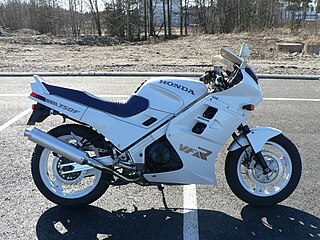
The Honda VFR750F is a motorcycle manufactured by Japanese automobile manufacturer Honda from 1986 to 1997. The motorcycle is a very sporty sport tourer, and is powered by a 750 cc (46 cu in) V4 engine developed from the earlier VF750F models. The VFR was announced in 1986, after an initial press viewing at the 1985 Bol d'Or.
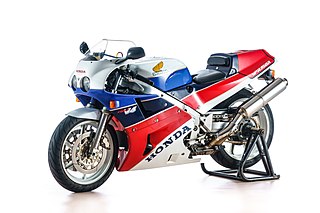
The Honda VFR750R, model code 'RC30', is a fully faired, solo-seat-only racing motorcycle created for homologation purposes for the World Superbike Championship by Honda Racing Corporation (HRC). It was first released to the Japanese market in 1987, released in Europe in 1988 then the United States in 1990. There were only 3,000 made and they sold for US$15,000 - a very large amount for a production bike at the time.

The VF1000 is a range of motorcycles produced by Honda from 1984 to 1988. The VF1000 is named after its V-4 998 cc (60.9 cu in) double overhead cam 16-valve engine. There were three main models in the VF1000 range, the VF1000F, the VF1000R and the VF1000F2.

A motorcycle engine is an engine that powers a motorcycle. Motorcycle engines are typically two-stroke or four-stroke internal combustion engines, but other engine types, such as Wankels and electric motors, have been used.

First introduced in 2003, the Ducati Multistrada is a series of V-twin and V4 touring focused motorcycles. Essentially a hybrid of a supermoto and a sport-tourer, the Multistrada competes in the market with other dual-sport motorcycles such as the BMW GS. The first iteration of the Multistrada was, like the Yamaha TDM850, neither intended nor suitable for off-road use. Subsequent models were more suited to a proper dual-sport role.

The Honda RC51, also known as the RVT1000R or VTR1000 SP1, is a 90° V-twin motorcycle produced by Honda from 2000 to 2006.

The Honda RVF400R (NC35) was a sport bike manufactured by Honda from 1994 to 1996. It was powered by a 16-valve double overhead geardriven cam 400 cc 90° V4 four-stroke engine, and was known for its handling capabilities.

The Honda RVF750R RC45 was a fully faired racing motorcycle created for homologation purposes for the Superbike World Championship by Honda Racing Corporation. The RVF750R was the successor to the VFR750R RC30. Like its predecessor, the RVF750R featured a DOHC liquid-cooled V4 4-stroke engine with gear driven cams and a single-sided swingarm, but unlike the RC30 it utilized electronic fuel injection, in a setup very similar to the production 1992 NR750. The US spec engine had a 749.2cc capacity and was rated at 101 horsepower; the European version was rated at 118 horsepower. A simple rewire modification to the PGM-FI box increased power in the US engine up to the 118 hp. It was manufactured from 1994 until 1995 and sold in limited numbers, followed by the VTR1000R SP-1 RC51 in 2000. Unlike the VFR750R RC30 and VFR750F from which the engine was originally derived the gear drive for the cams was moved from the centre of the engine in between the cylinders to the one side allowing a slightly narrower engine.

The Honda Sabre was a motorcycle made by Honda from 1982 to 1985. Two years of the Sabre production run were part of a group of Japanese motorcycles that came to be known as "tariff-busters". The 1984 and 1985 models fell in this class because of the modifications made allowing those models to circumvent the newly passed United States International Trade Commission tariff that placed a heavy tax on import/foreign motorcycles with 700cc or larger engine displacement.
The Suzuki Madura was a cruiser motorcycle sold by Suzuki in 1985 and 1986. It was available with either 1200 cc or 700 cc V4 engines. It was created as a response to Honda's Magna V4 muscle cruiser and was a direct competitor with Yamaha's V-Max power cruiser, also released in 1985.
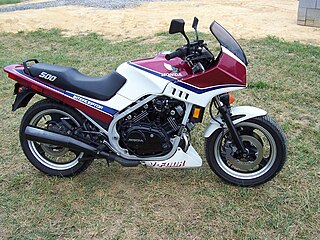
The Honda VF500F is a 498 cc (30.4 cu in) displacement sport motorcycle manufactured from 1984 to 1986. It is widely regarded as one of the finest handling motorcycles of the 1980s.

A motorcycle frame is a motorcycle's core structure. It supports the engine, provides a location for the steering and rear suspension, and supports the rider and any passenger or luggage. Also attached to the frame are the fuel tank and battery. At the front of the frame is found the steering head tube that holds the pivoting front fork, while at the rear there is a pivot point for the swingarm suspension motion. Some motorcycles include the engine as a load-bearing stressed member; while some other bikes do not use a single frame, but instead have a front and a rear subframe attached to the engine.

The Honda VFR1200F is the 7th generation Honda sport touring motorcycle from the VF and VFR line motorcycles powered by a transverse mounted V4 engine. The VFR1200F has several new technologies including the first dual clutch transmission offered on a motorcycle.

The Interceptor is a British motorcycle made by Royal Enfield between 1960 and 1970. The 700 Interceptor introduced in 1960 was a modified version of the company's 692 cc (42.2 cu in) Constellation model. In 1962, the company introduced the 750 Interceptor which evolved constantly until the end of production in 1970. In 2018, the Interceptor model was reintroduced as a 648 cc (39.5 cu in) parallel twin.

The Honda VF750F V45 Interceptor aka RC15 is a technologically advanced sports motorcycle produced by Honda from 1983 to 1985. Using a revised engine from the Sabre/Magna with chain drive and a five-speed gearbox the half-faired motorcycle was introduced with an 86-horsepower liquid-cooled double overhead cam (DOHC) V4 four-stroke engine in a steel perimeter frame.
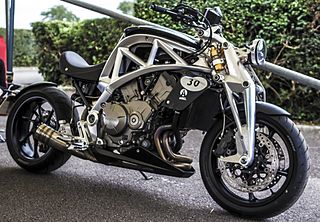
The Ariel Ace is a 2014 sports motorcycle that is manufactured by the British Ariel Motor Company in Crewkerne, Somerset, England. It uses the 1,200 cc (73 cu in) V4 engine from the Honda VFR1200.